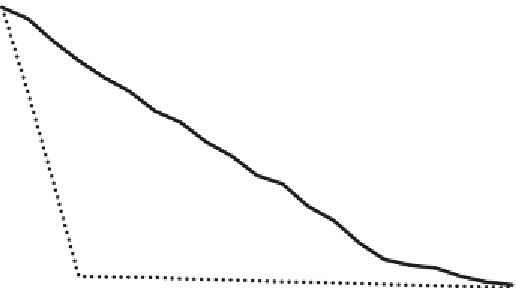what-when-how
In Depth Tutorials and Information
1
Wireless
Transport
Power
0.9
0.8
0.7
0.6
0.5
0.4
0.3
0.2
0.1
0
0
0.2
0.4
0.6
1
0.8
Fraction of Nodes Removed in Decreasing Order of Degree
Figure5.12
Sizeofthelargestcomponentinanetworkasafunctionofthefrac-
tionofnodesdeleted.Nodesweredeletedindecreasingorderofresidualdegree.
The panel depicts transportation, power, and wireless radio networks. (From
C. Barrett et al., Understanding large-scale social and infrastructure networks:
A simulation-basedapproach,
SIAM News
,Vol.37,No.4,pp.1-4,May2004.)
at different levels can be seen in Figure 5.12. As you can see, these graphs sup-
port the theory that social networks are more robust against node deletions than
infrastructural networks. One explanation for this could be due to the underly-
ing social contacts such as those found in the small-world social-network models.
he authors suggest that it is due to the similarity between social networks and
“expander graphs.” his is in contrast to the similarity between ad hoc networks
and random geometric graphs.
Expander graphs are graphs with high vertex expansion. In other words, any two
vertices on the graph are connected by a number of disjoint paths. Infrastructural
graphs such as power and transportation have low expansion, which in turn makes
attacks on high degree nodes more efective than random attacks. his robustness
of social networks can have some dangerous effects such as making it difficult to
contain an infectious disease or even a harmful rumor.
In Bergman et al. [6], the authors focus on a different method for modeling
large-scale social networks, namely, transitions. An example transition model would
be the transition of horse-drawn carriages to cars, or sailing ships to steamships.
Studying these historical transition models can help predict how current models
are transitioning and how they can be adapted for future models. he model in
Bergman et al. [6] combines agent-based modeling techniques and system dynam-
ics, and includes interactions of individual agents and subsystems, as well as cumu-
lative effects on system structures. To get a grasp of a transition model, focus must
be on understanding radical, systematic sociotechnical change; in other words,








































